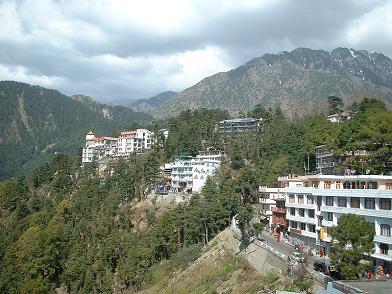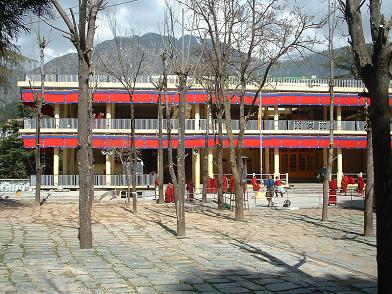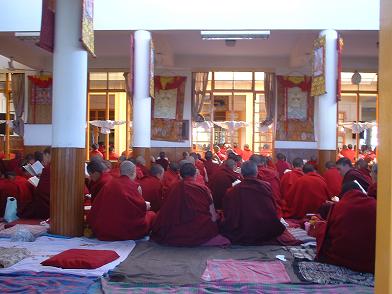Dharamshala the exile of Dalai Lama
Dharamshala is located in the north of India and is the exile of Dalai Lama and thousands of other Tibetans. Dharamshala lies in the middle of beautiful mountains -here starts the Himalaya!

On the street monks are gathering to get ready for the next prayer. They friendly bow and smile when they see visitors. In the building in the background the temple is located where the monks meet for meditation and for praying.

Here the building from the other side...hhmmm, this is the holy and spiritual centre of the Tibetans! A long time I have been looking forward to visit this place to learn more about Dalai Lama and the history of the Tibetans. But I didn't expect to come upon this place so simple and basic!

In this building the monks are praying and meditating the whole day. Puuuhh....what a life! I wouldn't change!

Unfortunatly the Dalai Lama himself didn't come to welcome us.
I think he is never there because he must be travelling all the time to find new followers for the liberation of Tibet.
Anyhow I learnt a lot about the Tibet conflict. I try to give a short summary about this subject:
The Tibet conflict
Relation Tibet-China
Until the 6th century Tibet was cut into different princedoms but then it expanded its power to Nepal, West Tibet and a part of India.
Tibet propagated the from India coming Buddhism and entered into China. In that time Buddhism was spreading over China. But in the 7th century the big Tibetan empire collapsed again in its princedoms. Chinas power became bigger and bigger and from the 13th century China had big political and cultural influence in Tibet. China tried to enter Tibet several times without any success. But Tibet managed to release from the Chinese influence and at the end of the 19th century it cut itself off from the rest of the world under the command of the Dalai Lama. The British who occupied India at that time saved the Tibetan voluntary isolation with the control of the Himalaya and in the year 1914 India, Great Britain and Russia decided the independence of Tibet. But China never accepted this decision!
The invasion of China in Tibet
1950, one year after the coming into power of the communists in China Chinese troops marched into Tibet. To embattle the public against the intruding Chinese army the that time very young 14th Dalai Lama was invested not just of the spiritual but also of the political power of Tibet. Anyhow the opposition was broken very fast and Tibet had to sign a dictated contract which gave the Dalai Lama the control of the internal power but military and foreign affairs was in the competence of China.
The escape of the Dalai Lama
In this time the education and public health system in Tibet was advanced under the Chinese influence but China also imposed a big pressure upon whole Tibet. For example 65000 Tibetan labours died under unhuman conditions by the construction of a street from Sinkiang and Szechwan fo Lhasa. Because of the forced labour and the closing of the lamaistic cloisters a opposition was formed which the Chinese wanted to break up by resettling the people: Tibetans were resettled to China and Chinese were located to Tibet.
Due to this sanction a guerrilla war started which was supported by the Tibetan public. After demonstrations in the biggest cities in Tibet turbulences began. The Chinese attacked the Tibetan cloisters and the domicile of the Dalai Lama who had to flee to exile in India. The demomstrations of the Tibetans ended with around 100000 deads and ten thousands had to flee to India where the Dalai Lama built a exile government.
1965 Tibet was announced as a autonomous region of the People's Republic of China and China implemented in Tibet a continous change to socialism.
The fight for independence
In the sixties and seventies the upcoming interest in Buddhism brought a lot of new contacts between Exile Tibetans and the west. The first public appearance of the Dalai Lama in the west was in 1979 on the Mount Pelerin in Geneva (Switzerland).
Further visits of the Dalai Lama in the west followed. The Buddhism became generally known as the religion of tolerance, piece and logic. A big number of new founded Tibet-Support-Groups brought the subject of the Tibetans to the public.
The Tibetans won easely the sympathy of the west and became known as peace loving, friendly and wrongly downtrodden people.
The Dalai Lama published 1988 in Strasbourg his Five-Point-Peace-Plan for Tibetan self responsibility and received one year later the Nobel peace price for his efforts for a free Tibet.
A free Tibet?
In spite of the tireless efforts of the Dalai Lama Tibet will probably never become free. One of the most important reasons for this is surely that China became a new economic power in the last decades. Which western economic power should pick out the independence of Tibet as a central theme if there's a big business to make?
Though China admits mistakes in Tibet in the past but in the same way it thinks to have helped Tibet because under the power of China Tibet developed significantly!
Well, sad story! But despite the tragical circumstances we shouldn't mix religious and political interests. Politically seen we could and should discuss a liberation of Tibet. But the Dalai Lama is not only the political but also the religious head of the Exile Tibetans so he often mixes the two different subjects. So it isn't suprising that a lot of people convert to Buddhism because of feeling sorry for the Tibetans and follow the Dalai Lama. The maybye most famous fan of Dalai Lama is the Hollywood star Richard Gere.
Although the Dalai Lama wasn't available to welcome me the visit in Dharamshala was very interesting anyway and I could learn a lot about the Tibetan people and their history.
Andy
02.04.04, Dharamshala, India